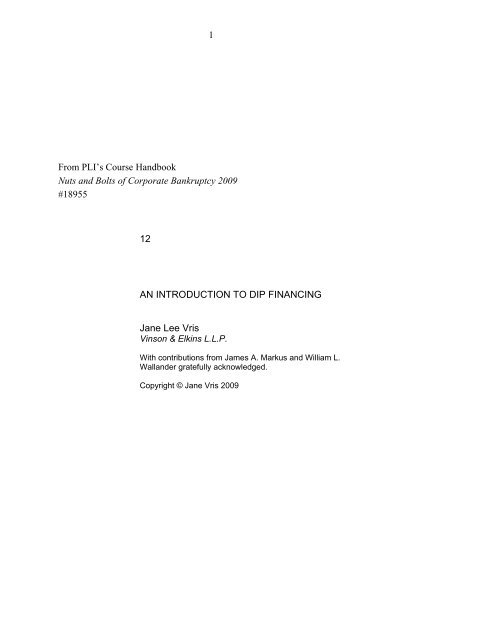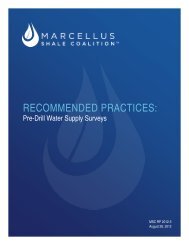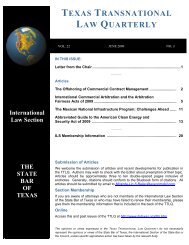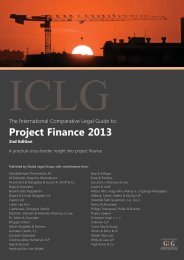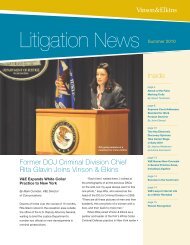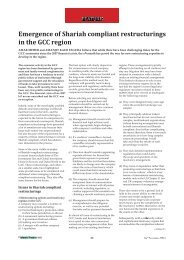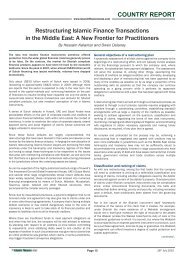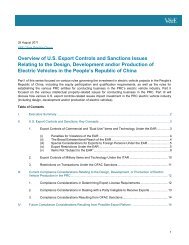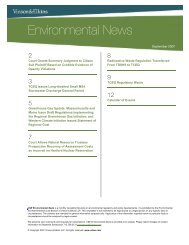12 AN INTRODUCTION TO DIP FINANCING Jane Lee
12 AN INTRODUCTION TO DIP FINANCING Jane Lee
12 AN INTRODUCTION TO DIP FINANCING Jane Lee
You also want an ePaper? Increase the reach of your titles
YUMPU automatically turns print PDFs into web optimized ePapers that Google loves.
1<br />
From PLI’s Course Handbook<br />
Nuts and Bolts of Corporate Bankruptcy 2009<br />
#18955<br />
<strong>12</strong><br />
<strong>AN</strong> <strong>INTRODUCTION</strong> <strong>TO</strong> <strong>DIP</strong> FIN<strong>AN</strong>CING<br />
<strong>Jane</strong> <strong>Lee</strong> Vris<br />
Vinson & Elkins L.L.P.<br />
With contributions from James A. Markus and William L.<br />
Wallander gratefully acknowledged.<br />
Copyright © <strong>Jane</strong> Vris 2009
2<br />
Part One: Statutory Overview<br />
Once a company becomes a chapter 11 debtor, any financing arrangement the<br />
company wishes to engage in will require authorization under the Bankruptcy<br />
Code. i This is true whether the financing is a continuation of an existing<br />
lending relationship or a new financing. Although this requirement is not<br />
stated directly, a number of provisions in the Bankruptcy Code effectively<br />
prohibit financings without authorization. Furthermore, even a company<br />
without a critical need for immediate financing will find that it requires<br />
authorization to use its cash in the event that cash is collateral. As a<br />
consequence, an understanding of the authorization needed and of the<br />
procedure for getting that authorization is a basic aspect of administration that<br />
every bankruptcy lawyer must know. These concepts are necessary not only<br />
for traditional credit arrangements, but also any extension of credit or<br />
incurrence of debt regardless of duration or size.<br />
1) Section 364: the primary provision for financing. Section 364 permits<br />
a trustee ii to obtain credit or incur a debt if it meets certain conditions.<br />
The provision allows the incurrence of both unsecured and secured<br />
debt. Although expressed as a permissive provision, as applied, the<br />
section effectively prohibits credit and debt transactions which do not<br />
meet its conditions. Section 364 is discussed in more detail in Part<br />
Two below. Financing provided after a case commences is typically<br />
referred to as “<strong>DIP</strong> financing” and the loans as “<strong>DIP</strong> loans”.<br />
2) Sale, use or lease of property. Section 363 permits a trustee to use, sell<br />
or lease property of the estate under certain circumstances. 11 U.S.C.<br />
§ 363. Cash collateral has special protection: a trustee may not use<br />
cash collateral without court approval or creditor consent. 11 U.S.C. §<br />
363(c)(2). Even if a trustee does not require new credit, it will need<br />
court approval to finance operations through use of cash collateral.<br />
Use of cash collateral under section 363 is discussed in more detail in<br />
Part Three below.<br />
3) Avoiding a financing transaction which has not been authorized.<br />
While section 364 allows a trustee to obtain credit or incur debt and, as
3<br />
applied, acts also as a prohibition for transactions which do not satisfy<br />
those conditions, there is another concept in the Bankruptcy Code<br />
which can trap the unwary: a trustee can “avoid” nearly all<br />
transactions involving “estate” property that were not properly<br />
authorized. 11 U.S.C. § 549(a). This concept is applicable generally<br />
to all transactions, not just those involving credit, and requires an<br />
understanding of the “estate” and avoidance to fully appreciate its<br />
impact on financings.<br />
(a)<br />
Creating the estate. The commencement of a chapter 11 case<br />
creates an “estate”. 11 U.S.C. § 541(a). Any property in<br />
which the chapter 11 debtor had an interest at the time of the<br />
case’s commencement becomes part of the estate. Id.<br />
(i)<br />
(ii)<br />
The estate includes tangible as well as all intangible<br />
property. Id. Thus, for example, all of a business’<br />
working capital becomes estate property, including<br />
accounts receivable and inventory. Inchoate property<br />
rights are also part of the estate, including all contract<br />
rights and causes of action.<br />
Estate property also includes all “[p]roceeds, product,<br />
offspring, rents, or profits of or from property of the<br />
estate.” 11 U.S.C. § 541(a)(6).<br />
(b)<br />
Post-petition transfers of estate property. Any transfer of<br />
property of the estate may be avoided if it is not authorized<br />
either by the court or under the statute (subject to very specific<br />
exceptions). 11 U.S.C. § 549(a). Given the comprehensive<br />
scope of the estate, any transaction or transfer in which a<br />
debtor engages is likely to be avoidable if not authorized. For<br />
example, the grant of a lien is a transfer of an interest in<br />
property of the estate. 11 U.S.C. § 101(54). Likewise, any<br />
unauthorized repayment of a debt made by a trustee after<br />
commencement of a case can be avoided. Section 364 is the<br />
chief source of authorization for permitting those transfers<br />
which are part of a financing, i.e., the grant of a lien or security<br />
interest and the repayment of an obligation. 11 U.S.C. § 364.
4<br />
(c)<br />
(d)<br />
Consequences of avoidance. If a transfer is avoided pursuant<br />
to section 549, a trustee may recover either the property<br />
transferred or the value of the property. 11 U.S.C. § 550(a).<br />
Recovery may be had from the initial transferee of the transfer,<br />
the party for whose benefit the transfer was made, or any<br />
immediate or mediate transferee of the initial transferee. 11<br />
U.S.C. § 550(a)(1). However, a transferee that “takes for<br />
value” and “without knowledge of the voidability of the<br />
transfer avoided” is sheltered from the avoidance of an<br />
unauthorized post-petition transfer. 11 U.S.C. § 550(b).<br />
Therefore, to the extent that a post-petition transfer is avoided<br />
pursuant to section 549, the transferee could be compelled to<br />
return the transfer or the value thereof, and could be left with a<br />
general unsecured claim pursuant to section 502(h) (unless the<br />
transferee could obtain retroactive approval as discussed in Part<br />
Two, 5 below). 11 U.S.C. § 502(h) (“[A] claim arising from<br />
the recovery of property under sections 522, 550, or 553 of this<br />
title shall be determined and shall be allowed . . . or<br />
disallowed . . ., the same as if such claim had arisen before the<br />
date of the filing of the petition.”)<br />
No lien on after-acquired property. A lender cannot rely on its<br />
right to an automatic lien on after-acquired property under state<br />
law to eliminate its exposure under section 549. Under section<br />
552(a), a lien granted under a security agreement entered into<br />
prior to the commencement of a case does not extend to<br />
property which becomes estate property after the case begins.<br />
11 U.S.C. § 552(a). Thus, even if under state law a lien would<br />
automatically extend to after-acquired property, once a case<br />
has commenced, that automatic grant terminates. However, as<br />
discussed in more detail in Part Three below, an important<br />
exception exists: a lien can extend to proceeds, including cash<br />
collateral. 11 U.S.C. § 552(b). Cutting off the automatic lien<br />
under state law while effectively prohibiting any grant of a lien<br />
once a case commences abruptly terminates many forms of<br />
financing even when a lender is willing to extend credit<br />
following the commencement of the case. To be able to
5<br />
continue a financing secured by an asset base which<br />
continually converts to cash and includes after-acquired assets<br />
– the working capital revolver is the classic example – a trustee<br />
must have the necessary authorization under section 364.<br />
Part Two: New Credit Under Section 364<br />
Section 364 is the basic Bankruptcy Code provision governing financing. It<br />
permits the trustee to obtain credit and incur debt in and out of the ordinary<br />
course of business and with a variety of priorities. The statutory scheme sets<br />
forth escalating levels of protection for the lender and requirements for<br />
obtaining that protection.<br />
1) Section 364(a). This section permits a trustee to incur unsecured debt<br />
in the ordinary course of business without court approval. 11 U.S.C. §<br />
364(a). The creditor’s claim will be accorded administrative expense<br />
priority. Id. Typically, this level of financing is used for trade credit.<br />
(a)<br />
(b)<br />
The term “ordinary course of business” has been interpreted by<br />
some, but not all, courts to require that the debt be incurred in<br />
the ordinary course of business both for the debtor and in the<br />
debtor’s line of business. See P.F. Three Partners v. Emery (In<br />
re Upland Partners), 208 Fed. Appx. 533 (9th Cir. 2006)<br />
(applying the vertical and horizontal approach to determine<br />
whether unsecured credit is obtained or debt is incurred in the<br />
ordinary course of business).<br />
Given the priority of an administrative expense claim, it will be<br />
paid before general unsecured claims and unsecured priority<br />
claims, but after (i) “superpriority” administrative expense<br />
claims; (ii) secured claims; and (iii) administrative expense<br />
claims of any superseding chapter 7 case. See 11 U.S.C. §§<br />
503(b), 507(a)(2), and 726(b).<br />
2) Section 364(b). This section allows a trustee to incur unsecured debt<br />
out of the ordinary course of business after notice and a hearing. 11<br />
U.S.C. § 364(b). The requirements for “notice and a hearing” apply<br />
for sections 364(c) and (d) as well, 11 U.S.C. § 364(c), (d), and are
6<br />
discussed in more detail in Part Five, 1 below. As with claims<br />
arising under section 364(a), the creditor’s claim under section 364(b)<br />
will be an administrative expense claim. 11 U.S.C. § 364(b).<br />
3) Section 364(c). This section provides three different types of<br />
protection available for a creditor, but only if the trustee can show that<br />
financing was not available without such protection after notice and<br />
hearing. 11 U.S.C. § 364(c). Although it may not be required to seek<br />
credit from every possible source, a debtor must affirmatively<br />
demonstrate that it has made a reasonable effort to seek other sources<br />
of available credit under sections 364(a) and (b), and the debtor is not<br />
entitled to merely assume that less onerous financing is unavailable.<br />
Suntrust Bank v. Den-Mark Const., Inc., 406 B.R. 683, 693 (E.D.N.C.<br />
2009) (unwillingness of pre-petition secured creditor to extend credit<br />
did not demonstrate unavailability of alternative financing for purposes<br />
of section 364(d)); In re Ames Dept. Stores, Inc., 115 B.R. 34, 40<br />
(Bankr. S.D.N.Y. 1990); see also Bray v. Shenandoah Fed. Sav. &<br />
Loan Ass’n (In re Snowshoe Co., Inc.), 789 F.2d 1085, 1088 (4th Cir.<br />
1986) (in context of obtaining credit secured by equal or senior lien,<br />
debtor in possession demonstrated inability to obtain credit by<br />
contacting financial institutions in immediate geographical area, and<br />
debtor in possession is under no obligation to seek credit from every<br />
possible lender), In re Plabell Rubber Prods., Inc., 137 B.R. 897, 899<br />
(Bankr. N.D. Ohio 1992) (meeting with one alternative lender was<br />
insufficient to demonstrate unavailability of financing).<br />
(a)<br />
A creditor may be granted an administrative expense claim<br />
with priority over all other administrative expense claims, or a<br />
“superpriority” administrative expense claim. 11 U.S.C. §<br />
364(c)(1). But see In re Mayco Plastics, Inc., 379 B.R. 691,<br />
698, 706 (Bankr. E.D. Mich. 2008) (holding that section<br />
364(c)(1) claim did not automatically entitle lender to an<br />
administrative expense claim without specific request or court<br />
authorization). Note that courts differ on whether the<br />
superpriority administrative expense claim will have priority<br />
over the administrative claims in a subsequent Chapter 7 case.<br />
Compare In re Energy Coop., Inc., 55 B.R. 957, 963 n.20<br />
(Bankr. N.D. Ill. 1985) (stating in dicta that a pre-conversion
7<br />
superpriority claim has priority over a chapter 7 administrative<br />
expense claim), with Citibank, N.A. v. Transamerica Comm.<br />
Fin. Corp. (In re Sun Runner Marine), 134 B.R. 4, 7 (9th Cir.<br />
B.A.P. 1991) (chapter 7 administrative expense claims have<br />
priority over chapter 11 superpriority claims).<br />
(b)<br />
(c)<br />
The claim can be secured by an asset not already subject to a<br />
lien. 11 U.S.C. § 364(c)(2).<br />
The claim can be secured by a lien junior to an existing lien.<br />
11 U.S.C. § 364(c)(3).<br />
4) Section 364(d). This section provides the third and final level of<br />
protection for the creditor advancing credit to the trustee. 11 U.S.C. §<br />
364(d). The creditor’s claim can be secured by a lien that is equal or<br />
senior to an existing lien. Id. Courts have confirmed that such<br />
“priming” of even a perfected lien is not an improper extinction of<br />
state law rights. See In re Levitt & Sons, LLC, 384 B.R. 630 (Bankr.<br />
S.D. Fla. 2008). As a practical matter, most creditors other than trade<br />
vendors (and perhaps those advancing funds to protect an existing<br />
investment) will want this level of protection.<br />
(a)<br />
(b)<br />
In addition to the showings required under section 364(c), the<br />
trustee must also show that the creditor with the existing lien<br />
on the property will be adequately protected. 11 U.S.C. §<br />
364(d)(1)(B). Adequate protection, discussed in Part Four<br />
below, is an important concept not only for <strong>DIP</strong> financings<br />
with priming liens, but also for financings funded through use<br />
of cash collateral. In many situations, the “adequate<br />
protection” requirement is an extremely difficult one for a<br />
trustee to satisfy in the face of an objection from the creditor<br />
with the existing lien.<br />
It is worth noting that in a recent decision, a court also<br />
considered whether the terms of the proposed financing were<br />
justified by the anticipated benefit to the debtor. See Barbara<br />
K. Enterprises, Inc., 2008 WL 2439649, at *14 (Bankr.<br />
S.D.N.Y. 2008) (finding that the equities of the case did not
8<br />
weigh in favor of allowing <strong>DIP</strong> financing creditor to prime<br />
existing creditor’s lien where debtor was seeking to use<br />
existing creditor’s cash collateral to fund a plan that was highly<br />
risky and speculative).
9<br />
5) Other issues.<br />
(a)<br />
(b)<br />
(c)<br />
Subparts of Section 364 separate and distinct. It is worth<br />
noting that the authorization of credit under one of the section<br />
364 alternatives does not imply authorization for less<br />
protection under another one of the alternatives, absent<br />
application for such additional relief. See In re Sobiech, <strong>12</strong>5<br />
B.R. 110, 115 (Bankr. S.D.N.Y. 1991), aff’d 131 B.R. 917<br />
(S.D.N.Y. 1991); see also In re Mayco Plastics, Inc., 379 B.R.<br />
691, 698, 706 (Bankr. E.D. Mich. 2008) (recognizing a scheme<br />
of escalating inducements available to negotiate financing, fact<br />
that the <strong>DIP</strong> lender held a superpriority claim under section<br />
364(c)(1) did not automatically give it an administrative<br />
expense claim).<br />
Retroactive approval. Courts will approve <strong>DIP</strong> financing<br />
retroactively only under certain circumstances. See Sherman v.<br />
Harbin (In re Harbin), 486 F.3d 510, 523 (9th Cir. 2007)<br />
(applying the following four-factor test to determine that a<br />
bankruptcy court properly approved <strong>DIP</strong> financing pursuant to<br />
section 364(c)(2) on a retroactive basis: “(1) whether the<br />
financing transaction benefits the bankruptcy estate; (2)<br />
whether the creditor has adequately explained its failure to seek<br />
prior authorization or otherwise established that it acted in<br />
good faith when it failed to seek prior authorization;<br />
(3) whether there is full compliance with the requirements of<br />
section 364(c)(2); and (4) whether the circumstances of the<br />
case present one of those rare situations in which retroactive<br />
authorization is appropriate”). But see In re Ockerlund Constr.<br />
Co., 308 B.R. 325, 329 (Bankr. N.D. Ill. 2004) (refusing to<br />
approve <strong>DIP</strong> financing retroactively pursuant to sec. 364(b)).<br />
Cross-collateralization. The protections afforded by section<br />
364 are for the benefit of the debt arising under the new<br />
financing. Creditors who provided secured financing prior to<br />
the filing and who are willing to continue advancing funds to<br />
the trustee may seek to improve their pre-petition claims by<br />
securing those claims with after-acquired assets. Because
10<br />
section 552 cuts off liens on after-acquired property (see Part<br />
One, 3(d) above), the ability to “cross-collateralize” the prepetition<br />
claims may be a significant reason a creditor is willing<br />
to continue extending credit.<br />
There is no authority in the Bankruptcy Code for crosscollateralization.<br />
As noted above, section 549 makes any<br />
transfer without authority avoidable. Some courts have been<br />
willing to authorize cross-collateralization under the general<br />
equity powers that section 105 gives the bankruptcy courts.<br />
Compare Burchinal v. Cent. Wash. Bank (In re Adams Apple,<br />
Inc.), 829 F.2d 1484, 1490-91 (9th Cir. 1987) (within the<br />
context of a mootness analysis, cross-collateralization<br />
provisions are authorized under the Bankruptcy Code), with<br />
Shapiro v. Saybrook Mfg. Co., Inc. (In re Saybrook Mfg. Co.,<br />
Inc.), 963 F.2d 1490, 1494-95 (11th Cir. 1992) (“crosscollateralization<br />
is not authorized as a method of post-petition<br />
financing under section 364 … [and] it is beyond the scope of<br />
the bankruptcy court’s inherent equitable power because it is<br />
directly contrary to the fundamental priority scheme of the<br />
Bankruptcy Code”), and In re Tri-Union Develop. Corp., 253<br />
B.R. 808, 814 (Bankr. S.D. Tex. 2000) (“[I]t is improper under<br />
the current Code and caselaw for the debtor, pre-confirmation,<br />
to cross-collateralize or ‘refinance and re-collateralize’ a prepetition<br />
secured debt secured by substantially all of the<br />
debtor’s assets.”).<br />
Part Three: Use of Cash Collateral Under Section 363<br />
A debtor which files with substantial cash reserves may not need new<br />
financing; it may be able to survive with the cash it has at filing and cash<br />
generated from operations and asset sales. However, if that cash is collateral,<br />
the trustee may not use the cash without satisfying the requirements of section<br />
363.<br />
1) Use of Cash Collateral. Cash collateral is given special treatment<br />
under section 363. Generally, a trustee may use, sell or lease property<br />
without notice and a hearing if the transaction is in the ordinary course
11<br />
of business. 11 U.S.C. § 363(c)(1). If a transaction is out of the<br />
ordinary course of business, authority can be granted only after “notice<br />
and a hearing”. 11 U.S.C. § 363(b). The requirements of “notice and a<br />
hearing” are discussed in more detail in Part Five, 1 below.<br />
However, cash collateral cannot be used unless the party with an<br />
interest in the cash collateral consents or the court authorizes the use<br />
after notice and a hearing. 11 U.S.C. § 363(c)(2). To the extent that<br />
cash collateral is to be used outside of the ordinary course of business<br />
(and even if the party with an interest consents), the trustee should<br />
seek court approval. See 11 U.S.C. § 363(b)(1). Upon the request of a<br />
secured creditor, the trustee’s use of cash collateral may be<br />
conditioned on the providing of adequate protection of the secured<br />
creditor’s interest in that collateral. 11 U.S.C. § 363(e). The trustee<br />
must segregate and account for all cash collateral. 11 U.S.C. §<br />
363(c)(4).<br />
2) Cash collateral defined. Cash collateral is defined in section 363(a) as<br />
follows:<br />
‘[C]ash collateral’ means cash, negotiable instruments,<br />
documents of title, securities, deposit accounts, or other cash<br />
equivalents whenever acquired in which the estate and an<br />
entity other than the estate have an interest and includes the<br />
proceeds, products, offspring, rents, or profits of property and<br />
the fees, charges, accounts or other payments for the use or<br />
occupancy of rooms and other public facilities in hotels, motels,<br />
or other lodging properties subject to a security interest as<br />
provided in section 552(b) of this title, whether existing before<br />
or after the commencement of a case under this title.<br />
11 U.S.C. § 363(a).<br />
(a)<br />
The specific inclusion of “proceeds, products, offspring,” etc.<br />
parallels the cutoff provision of section 552(b). 11 U.S.C. §<br />
552(b). Generally, section 552(b) cuts off any lien which<br />
might arise under state law in after-acquired property. See Part<br />
One, 3(d). There are important exceptions in section 552(b),
<strong>12</strong><br />
and these exceptions are the same forms of property included<br />
in the definition of cash collateral.<br />
(i)<br />
(ii)<br />
(iii)<br />
Although the definition of “cash collateral” in section<br />
363 does not appear in toto in section 552(b), when<br />
subsections 552(b)(1) and (2) are taken together, they<br />
encompass all of the property in the definition of “cash<br />
collateral”.<br />
Section 552(b)(1) extends a security interest existing on<br />
the petition date to all “proceeds, products, offspring, or<br />
profits of such property” so long as both the security<br />
agreement and applicable nonbankruptcy law provide<br />
for the lien to extend to those types of collateral. 11<br />
U.S.C. § 552(b)(1). The court has the equitable power<br />
to limit this exception. Id. For example, the court can<br />
limit a lien on inventory which might otherwise extend<br />
to the receivable generated from the sale of that<br />
inventory to the value of the inventory as it existed on<br />
the petition date. Any portion of the receivable<br />
attributable to value contributed by the debtor’s estate<br />
either by finishing the inventory or marketing and<br />
distributing the inventory may be free of the prepetition<br />
lien.<br />
Significantly, section 552(b)(2) allows the security<br />
interest in assets existing on the commencement date to<br />
extend to assets which might not technically be<br />
proceeds under the Uniform Commercial Code but<br />
which derive from the pre-petition collateral. 11 U.S.C.<br />
§ 552(b)(2). For example, if a lender has a lien on real<br />
estate and its rents, section 552(b)(2) allows the<br />
lender’s lien to continue in rent paid after the petition<br />
date without taking any of the actions state law may<br />
require to perfect the security interest. Id. Absent the<br />
exception in section 552(b), a lender might find itself<br />
stayed under section 362 from taking action necessary<br />
under state law to perfect its interest in rents with the
13<br />
result that the cash generated by rents would become<br />
part of the debtor’s estate free of the lender’s lien. Here,<br />
too, the court may deny the lien or limit its value for<br />
equitable reasons. Id.<br />
(b)<br />
(c)<br />
Adequate Protection. If requested by a secured creditor, the<br />
trustee must provide adequate protection for the use of cash<br />
collateral. 11 U.S.C. § 363(e). The requirements of adequate<br />
protection are discussed in more detail in Part Four below.<br />
Adequate protection is not an express condition to the use of<br />
cash collateral under section 363; rather, it must be provided<br />
“on request of an entity that has an interest” in the cash<br />
collateral. Id. There is a risk that adequate protection may<br />
only be provided for cash collateral used after the secured<br />
creditor has requested adequate protection; a secured creditor<br />
must therefore be ready to file such a request immediately upon<br />
filing of the case if the debtor has not negotiated a consensual<br />
arrangement for use of cash collateral before the petition date.<br />
See In re Best Prod. Co., Inc., 138 B.R. 155, 157-58 (Bankr.<br />
S.D.N.Y. 1992) (creditor must seek adequate protection prior<br />
to the depreciation of the subject collateral); Ahlers v. Norwest<br />
Bank, 794 F.2d 388, 395 (8th Cir. 1986), rev’d on other<br />
grounds, 485 U.S. 197 (1988) (same); In re Greives, 81 B.R.<br />
9<strong>12</strong>, 965 (Bankr. N.D. Ind. 1987) (“[t]here is imposed on . . . a<br />
secured creditor the obligation to be diligent in requesting<br />
adequate protection”).<br />
Financing through the use of cash collateral. The broad<br />
definition of “cash collateral” in section 363 will generally<br />
catch all cash collateral existing on the petition date as well as<br />
all cash proceeds of collateral existing on the petition date. For<br />
the debtor in real estate, it will also include all rents and hotel<br />
revenues from room occupancy. See 11 U.S.C. §§ 363, 552.<br />
(An interesting question is whether revenues from the sale of<br />
services constitute cash collateral in which a creditor’s lien will<br />
attach. For a discussion of this, see In re Cafeteria Operators,<br />
L.P., 299 B.R. 400, 410 (Bankr. N.D. Tex. 2003) (portion of<br />
restaurant revenues associated with use of the actual inventory
14<br />
and personal property constitutes cash collateral), cited with<br />
approval in In re Skagit Pacific Corp., 316 B.R. 330, 336 (9th<br />
Cir. B.A.P. 2004)). It may be possible for the trustee to finance<br />
the business with the estate’s cash without getting any new<br />
credit, but if the cash is collateral, as a practical matter the<br />
trustee must enter into a financing agreement with the secured<br />
creditor<br />
(d)<br />
There are no provisions specifying forms of protection<br />
comparable to those in section 364 (see Part Two above) that a<br />
trustee can offer a secured creditor for use of cash collateral.<br />
Instead, the trustee must provide “adequate protection”. 11<br />
U.S.C. § 363(e). As discussed in greater detail in Part Four<br />
below, adequate protection itself can take several forms,<br />
including periodic payment of cash and replacement liens. 11<br />
U.S.C. § 361.<br />
A typical form of consensual cash collateral financing gives the<br />
secured creditor periodic cash payments which approximate<br />
interest payments at either the contractual rate or a new<br />
negotiated rate. 11 U.S.C. § 361(1). It will also give the<br />
secured creditor replacement liens, an important and necessary<br />
protection overriding the effect of section 552(a). 11 U.S.C. §<br />
361(2).<br />
Examples:<br />
Working Capital Revolver Overview: Consider a working<br />
capital revolver: the lender has a lien on all of the debtor’s cash,<br />
accounts receivable and inventory on the petition date. Once<br />
the case commences, the lender continues to have a lien on (1)<br />
the cash existing on the petition date, (2) the cash generated by<br />
the collection of receivables on the petition date, (3) the<br />
receivables generated by the inventory existing on the petition<br />
date, subject to any equitable limitation on that lien imposed by<br />
the court (see Part Two, 3(a) above) and (4) any inventory<br />
and receivables which have not turned over since the petition<br />
date. Once the debtor uses the cash collateral to purchase more
15<br />
inventory, the secured creditor no longer has a lien on that new<br />
inventory; the lien is cut off under section 552(b).<br />
Consequently, the secured creditor will also not have a lien on<br />
the receivables generated by that new inventory or the cash<br />
generated from the collection of those receivables. Under a<br />
consensual form of cash collateral financing, the secured<br />
creditor may agree to the use of cash collateral so long as it<br />
receives, in addition to periodic cash payments, a replacement<br />
lien on all new inventory, receivables and cash.<br />
The Rollup: The working capital lender may also insist that all<br />
cash remaining after the periodic cash payments be applied to<br />
the pre-petition debt. Of course, if all of the debtor’s cash is<br />
used to repay the lender’s pre-petition debt, then any new cash<br />
the debtor requires must come from a new extension of credit.<br />
When the lender receives all a debtor’s cash from operations,<br />
applies that cash to its pre-petition debt, and then advances new<br />
financing, this arrangement is referred to as a “roll-up”. Over<br />
time, this has the effect of converting the entire pre-petition<br />
facility into a <strong>DIP</strong> facility, with all of the procedural and<br />
priority advances of a post-petition facility. (<strong>DIP</strong> financing<br />
orders are discussed in more detail in Part Six below.) For this<br />
reason, cash collateral agreements are often structured as<br />
agreements both for <strong>DIP</strong> financing and use of cash collateral.<br />
Unlike the concerns over cross-collateralization, courts<br />
generally will allow this type of “rollup” facility, particularly if<br />
the new facility has at least the potential for truly advancing<br />
new credit (that is, increasing the aggregate amount of the<br />
lender’s pre- and post-petition claims to an amount greater than<br />
the lender’s exposure on the petition date). Indeed, courts may<br />
allow the lender to advance an amount with the first borrowing<br />
which is sufficient to repay the pre-petition loan completely,<br />
thereby converting the pre-petition debt to post-petition debt<br />
before the lender’s exposure is increased by post-petition<br />
borrowings. If the payment of pre-petition debt is part of the<br />
negotiated package for a <strong>DIP</strong> lender, then such term should be<br />
disclosed as part of the record and included in the <strong>DIP</strong>
16<br />
financing order. See In re Berry Good, LLC, 400 B.R. 741<br />
(Bankr. D. Ariz. 2008).<br />
Part Four: Adequate Protection<br />
A debtor which requires financing, whether in the form of new credit, use of<br />
cash collateral or a combination of both, must in most cases be prepared to<br />
offer “adequate protection”. 11 U.S.C. §§ 363(e), 364(d)(1). Adequate<br />
protection is a concept designed to protect a secured creditor’s interest in<br />
property from some, but not all, of the effects of a bankruptcy filing. iii In<br />
addition to adequate protection in connection with financings under section<br />
364 and use of cash collateral under section 363, adequate protection must<br />
also be provided to a party with an interest in any estate property the trustee<br />
uses, sells or leases and to any party stayed from taking action by virtue of the<br />
automatic stay under section 362. While sections 362 (automatic stay), 363<br />
(use, sale or lease of property) and 364 (<strong>DIP</strong> financing) all require adequate<br />
protection, section 361 is the starting point for understanding the concept; it<br />
describes illustrative forms of adequate protection and identifies what it is that<br />
must be protected. iv Note that junior lienholders are not entitled to adequate<br />
protection if the value of the collateral is less than the debt secured by the<br />
more senior lien. In re Levitt & Sons, LLC, 384 B.R. 630, 642 (Bankr. S. D.<br />
Fla. 2008).<br />
1) Overview of section 361. There are three forms of protection described<br />
in section 361. See 11 U.S.C. § 361. Although generally considered<br />
illustrative and not exclusive, the third category itself operates as a<br />
catch-all. Taken together, the statute gives parties considerable<br />
flexibility in fashioning the type of protection a court can approve.<br />
Adequate protection is available for the creditor who has consented<br />
either to the use of cash collateral or to new liens on its collateral;<br />
typically, the form and amount of adequate protection will be<br />
negotiated and memorialized in an adequate protection stipulation (or<br />
agreed order). <strong>DIP</strong> financing orders are discussed in more detail in<br />
Part Six below. Adequate protection is also available to the objecting<br />
creditor. That is, the court may approve the use of cash collateral or<br />
the new liens on the creditor’s collateral without the creditor’s consent,<br />
so long as the creditor’s interest is adequately protected. In this
17<br />
nonconsensual situation, valuation is likely to be contested. Valuation<br />
of collateral is discussed in further detail in 1(c)(ii) below.<br />
(a)<br />
Section 361(1). A single cash payment or periodic cash<br />
payments can protect against “a decrease in the value of [the<br />
secured creditor’s] interest” in property. In practice, this will<br />
much more likely take the form of periodic cash payments than<br />
a single cash payment. It is worth repeating here that the<br />
interests protected are not just security interests; they can be<br />
any interest a party may have in property of the estate.<br />
However, when examining the interests affected by use of cash<br />
collateral or liens granted to secure new financing, those<br />
interests are almost always security interests.<br />
(i)<br />
(ii)<br />
A single cash payment is not likely to be used, whether<br />
for use of cash collateral or new financing, for the<br />
obvious reason that if the debtor had available free cash<br />
equal to the new financing or cash collateral it seeks to<br />
use, it would not need to use the cash collateral or the<br />
new financing in that amount.<br />
Periodic cash payments may be very useful either for<br />
use of cash collateral or new financing. It may be used<br />
alone or in combination with replacement liens. See,<br />
for example, the discussion of the cash collateral<br />
arrangement in Part Three above. The amount of the<br />
payment may approximate an interest rate, although<br />
often the order approving the periodic cash payments<br />
will not specify whether the payment should in fact be<br />
characterized as an interest payment or not. v<br />
(b)<br />
Section 361(2). The trustee may give the existing creditor<br />
additional or replacement liens for “a decrease in the value of<br />
such entity’s interest.”<br />
(i)<br />
As noted above, replacement liens can be combined<br />
with periodic cash payments effectively to continue a<br />
working capital revolver or similarly structured
18<br />
financing, often on a consensual basis. See Part Three,<br />
2(d) above. If the financing is not consensual, the<br />
valuation battle between the trustee and the existing<br />
creditor may focus on the profitability of the debtor’s<br />
business. If the debtor is losing money, continuing the<br />
same financing as existed prior the commencement of<br />
the case may not adequately protect the creditor; it is<br />
losing collateral value through the continued operation<br />
of the debtor’s business.<br />
(ii)<br />
When additional or replacement liens are used without<br />
the consent of the existing creditor, litigation may also<br />
focus on the value of the new security interest being<br />
given. It may also raise questions about the liquidity of<br />
the asset in which the lien is to be given. For example,<br />
if a debtor has a building under construction and wants<br />
to use cash collateral to continue work on the building,<br />
the existing creditor may reasonably complain that an<br />
unfinished building is not of the same quality as cash –<br />
whatever its value may be, that value is more<br />
speculative than cash. Further, the building may<br />
already have liens which will be senior to the proposed<br />
lien, and again, a junior lien on real estate is not as<br />
desirable a form of collateral as cash. Finally, the value<br />
of the interest the debtor proposes to give the existing<br />
creditor may be disputed. The debtor may place a value<br />
on the building which at least partially includes the<br />
value it expects once the building is “used and useful”<br />
while the creditor may assert that, at least until finished,<br />
the building is worth no more than the sum of the<br />
building materials. These sorts of litigation issues have<br />
no certain outcome and many parties will attempt to<br />
negotiate consensual adequate protection packages to<br />
avoid that uncertainty even if the existing creditor is not<br />
willing to provide new financing.<br />
(c)<br />
Section 361(3). The final form of adequate protection is a<br />
catch-all. It allows a court to grant “such other relief . . . as
19<br />
will result in the realization by such entity of the indubitable<br />
equivalent of such entity’s interest in such property.” The only<br />
express limitation is that an administrative expense claim will<br />
not suffice. (Note: a creditor extending new credit may agree<br />
to an administrative expense claim, as for example, with trade<br />
credit. Allowing an administrative expense priority for the new<br />
obligation incurred by the trustee is different than providing<br />
that type of priority as protection a trustee must give a creditor<br />
whose existing interest is being impaired, either by new<br />
secured financing or by use of cash collateral. It is this latter<br />
use of the administrative expense priority that section 361(3)<br />
prohibits.) A common form of “indubitable equivalent” is an<br />
equity cushion.<br />
(i)<br />
(ii)<br />
Trustees often propose the existence of an equity<br />
cushion as adequate protection for a nonconsenting<br />
creditor. See e.g., In re Gallegos Research Group,<br />
Corp., 193 B.R. 577, 585 (Bankr. D. Colo. 1995)<br />
(where the value cushion is substantial and is sufficient<br />
to provide for all of the creditor’s claims, additional<br />
protection may not be required). The trustee may argue<br />
that the value of the collateral remaining after the<br />
proposed use of cash collateral or net of all the senior<br />
liens to be granted is still sufficient to cover the existing<br />
creditor’s position. Note that creditors junior to the<br />
moving creditor need not be taken into account. See In<br />
re Jordan, 392 B.R. 428 (Bankr. D. Idaho 2008)<br />
(“[E]quity cushion exists where the value of the<br />
property is sufficient to fully secure the moving creditor,<br />
even if there is insufficient value to provide the debtor<br />
with equity when creditors junior to the movant are also<br />
considered.”).<br />
Valuation is obviously key to determining whether an<br />
equity cushion adequately protects the objecting<br />
creditor’s interest, and issues may arise with respect to<br />
the appropriate method to value collateral. Alternative<br />
methods to value collateral, in various contexts, include
20<br />
going concern, liquidation, and fair market values. In<br />
general, when valuing collateral under section 506(a) of<br />
the Bankruptcy Code, the appropriate method will<br />
depend on the purpose of the valuation and of the<br />
intended use or disposition of the collateral. 11 U.S.C.<br />
§ 506(a); see In re Rash, 520 U.S. 953, 962 (1997)<br />
(“the ‘proposed disposition or use’ of the collateral is of<br />
paramount importance to the valuation question”); see<br />
also In re Penz, 102 B.R. 826, 828 (Bankr. E.D. Okla.<br />
1989) (explaining that “when a debtor intends to<br />
continue use of creditor’s collateral, the debtors are<br />
acknowledging the value of the collateral to be greater<br />
than if liquidated [and t]herefore, creditor’s secured<br />
claim is entitled to be valued to the extent of its<br />
contribution to the entire estate vis-à-vis ‘going concern<br />
value’ not a mere liquidation value”).<br />
(iii)<br />
Some courts are reluctant to approve an equity cushion<br />
by itself. In re Strug-Division LLC, 380 B.R. 505, 513<br />
(Bankr. N.D. Ill. 2008) (equity cushion alone<br />
insufficient to provide existing lender with indubitable<br />
equivalent), In re Stoney Creek Tech., LLC, 364 B.R.<br />
882, 891 (Bankr. E.D. Pa. 2007) (evaluating the<br />
following factors to determine whether a movant is<br />
entitled to adequate protection: (i) whether the accrual<br />
of interest erodes the equity cushion; (ii) whether the<br />
property is depreciating or increasing in value; (iii)<br />
whether the debtor has shown an inability to obtain refinancing<br />
since the petition date; (iv) whether the debtor<br />
has offered any other methods of adequate protection;<br />
(v) whether there is a realistic prospect for successful<br />
reorganization; and (vi) whether the debtor’s conduct in<br />
the litigation evidences only a deliberate delaying<br />
tactic). The size of an acceptable equity cushion may<br />
vary widely depending on the circumstances. See In re<br />
Campbell Sod, Inc., 378 B.R. 647, 654-55 (Bankr. D.<br />
Kan. 2007) (where bank’s collateral was likely to
21<br />
increase in value due to the working capital infusion<br />
provided by the new financing, and debtor had a good<br />
chance of a successful reorganization, bank was<br />
adequately protected by equity cushion), Bargas v. Rice<br />
(In re Rice), 82 B.R. 623, 627 (Bankr. S.D. Ga. 1987)<br />
(equity cushion in real property alone not adequate<br />
protection; equity cushion was less than 5 percent and<br />
inherent delay and likely costs of sale would cause<br />
depreciation in creditor’s interest); cf. In re Riverfront<br />
Properties, 405 B.R. 570 (Bankr. D.S.C. 2009) (in<br />
context of secured creditor’s motion for relief from stay<br />
to reopen pre-petition foreclosure sale, equity cushion<br />
of at least 20%, in real estate combined with periodic<br />
payments, escrow of property taxes and share in net<br />
profit of restaurant operated on property sufficient<br />
adequate protection).<br />
This weighing of factors can be especially important in<br />
the context of bankrupt real estate developers, where,<br />
often, the pre-petition secured creditor will have a lien<br />
on the property to be developed, such that its collateral<br />
will be much more valuable with a capital infusion to<br />
complete the development. But, the <strong>DIP</strong> lender is likely<br />
not to provide such capital infusion without priming the<br />
existing secured lender under section 364(d).<br />
Consequently, the court must forecast the likelihood of<br />
sufficient increase in value of the collateral to<br />
determine if the pre-petition lender is adequately<br />
protected to justify the priming lien, and the use of the<br />
cash collateral. Such a projection is inherently fact<br />
sensitive, with no one factor being determinative. See,<br />
e.g., Suntrust Bank v. Den-Mark Const., Inc., 406 B.R.<br />
683, 689, 702 (E.D.N.C. 2009) (up to 11% equity<br />
cushion, increased value of collateral due to new capital<br />
infusion and monthly interest payments was<br />
nonetheless insufficient because the risk of realizing<br />
increased value was high and contingent on sale of
22<br />
finished lots, the value of the collateral decreased with<br />
each sale and the secured lender was not offered extra<br />
collateral and would be forced to look to least valuable<br />
collateral for repayment), In re Strug-Division LLC,<br />
380 B.R. 505 (Bankr. N. D. Ill. E. Div. 2008) (projected<br />
increase in value of apartment complex from<br />
renovations would not adequately protect pre-petition<br />
secured lender where value would at best narrowly<br />
exceed aggregate amount owed to first priority and<br />
priming lenders, there was substantial uncertainty as to<br />
completion of renovations and, with unrentable nature<br />
of apartments, property was unlikely to generate<br />
revenues sufficient to service the first priority lender’s<br />
debt).<br />
Part Five: Procedure<br />
In most circumstances, a trustee may only use cash collateral or obtain new<br />
credit “after notice and a hearing”. 11 U.S.C. §§ 363(b)(1), 363(c)(2)(B),<br />
364(b), 364(c), 364(d).<br />
1) “After Notice and a Hearing” Defined. Section 102(1) defines “‘after<br />
notice and a hearing’, or a similar phrase” to mean “after such notice<br />
as is appropriate in the particular circumstances, and such opportunity<br />
for a hearing as is appropriate in the particular circumstances.” 11<br />
U.S.C. § 102(1)(A). However, “after notice and a hearing” does not<br />
necessarily require a hearing. 11 U.S.C. § 102(B) (providing that an<br />
“actual hearing” is not necessary if proper notice is given and (i) a<br />
hearing is not timely requested by a party in interest; or (ii) insufficient<br />
time exists for a hearing to be conducted). Query whether there are<br />
any circumstances that warrant lack of notice. See Suntrust Bank v.<br />
Den-Mark Const., Inc., 406 B.R. 683, 689–90 (E.D.N.C. 2009) (failure<br />
to notify all lienholders precluded a finding of adequate protection as<br />
required under section 363(d) as a matter of law). However, those<br />
concepts may be modified by sections 363 and 364 and Rule 4001 of<br />
the Federal Rules of Bankruptcy Procedure.
23<br />
2) Procedural Requirements under Sections 363 and 364. Section 363<br />
has certain provisions that relate to any hearings to be conducted with<br />
respect to the use, sale, or lease of property, including cash collateral.<br />
See 11 U.S.C. § 363(c)(3) and (p). Pursuant to section 363(c)(3), a<br />
hearing to authorize the use of cash collateral may be on a preliminary<br />
basis to be “scheduled in accordance with the needs of the debtor.” 11<br />
U.S.C. § 363(c)(3). Further, the hearing may be consolidated with a<br />
hearing to determine whether the secured creditor’s interest in the cash<br />
collateral will be adequately protected. Id.; see also 11 U.S.C. §<br />
363(e). To the extent that a preliminary hearing on the use, sale, or<br />
lease of property is held, the Court should authorize such use, sale, or<br />
lease “only if there is a reasonable likelihood that the trustee will<br />
prevail at the final hearing” under section 363(e). 11 U.S.C.<br />
§ 363(c)(3).<br />
In any hearing in which the trustee requests relief with respect to<br />
section 363, the trustee has the burden of proof with respect to the<br />
providing of adequate protection, and the party asserting an interest in<br />
property has the burden of proof with respect to the validity, priority,<br />
or extent of its interest. 11 U.S.C. § 363(p). Similarly, the trustee has<br />
the burden of proof when it wants to secure <strong>DIP</strong> financing with senior<br />
liens to show that those liens will be adequately protected. 11 U.S.C.<br />
§ 364(d)(2).<br />
3) Procedural Requirements under Bankruptcy Rule 4001. In addition to<br />
the requirements set forth in sections 363 and 364, a trustee seeking to<br />
use cash collateral or obtain new credit must comply with Bankruptcy<br />
Rule 4001(b) (with respect to cash collateral) and 4001(c) (with<br />
respect to new credit). Pursuant to Bankruptcy Rule 4001(b), a trustee<br />
must serve a cash collateral motion or a <strong>DIP</strong> financing motion (each of<br />
which should be made in accordance with Bankruptcy Rule 9014) on<br />
the following parties:<br />
• Any committee elected pursuant to section 705 or appointed<br />
pursuant to section 1102;
24<br />
• If no committee has been appointed pursuant to section 1102 in<br />
a chapter 11 reorganization, on the parties identified on the list<br />
of top 20 creditors; and<br />
• Any other entity that the court may direct.<br />
Fed. R. Bankr. P. 4001(b)(1) and (c)(1). A cash collateral motion also<br />
should be served on any entity that has an interest in the cash collateral.<br />
Fed. R. Bankr. P. 4001(b)(1). The proposed financing agreement must<br />
be attached to the <strong>DIP</strong> financing motion. Fed. R. Bankr. P. 4001(c)(1).<br />
A final hearing on a cash collateral motion or a <strong>DIP</strong> financing motion<br />
may not be commenced earlier than 15 days after service of such<br />
motion. Fed. R. Bankr. P. 4001(b)(2) and (c)(2). However, a court<br />
may conduct a preliminary hearing on such motion before the 15-day<br />
period expires, but it may authorize the use of cash collateral or<br />
obtaining of <strong>DIP</strong> financing only as necessary to avoid “immediate and<br />
irreparable harm to the estate pending a final hearing.” Id.<br />
4) Local Rules and Standing Orders. In addition, many jurisdictions have<br />
local rules and standing orders relating to requests to use cash<br />
collateral or obtain new credit. The following bankruptcy courts are<br />
among those that have such local rules and standing orders:<br />
• Central District of California: Statement pursuant to Local<br />
Bankruptcy Rule 4001-2 (Cash Collateral Stipulations);<br />
• District of Delaware: See L. R. Bankr. P. 4001-2;<br />
• Northern District of Illinois: See L. R. Bankr. P. 4001-2;<br />
• Southern District of New York: See S.D.N.Y. LBR 4001-2;<br />
• Northern District of Texas: Attorney Checklist concerning<br />
Motions and Orders Pertaining to Use of Cash Collateral and<br />
Post-Petition Financing (Which Are in Excess of Ten (10)<br />
Pages).
25<br />
Generally, most, if not all, of those local rules and standing orders<br />
address (and sometimes discourage the request for) the following<br />
forms of relief in proceedings to approve the use of cash collateral and<br />
to obtain new credit.<br />
• cross-collateralization;<br />
• findings relating to the validity or perfection of liens;<br />
• waivers of section 506(c) rights;<br />
• grants of liens on avoidance actions;<br />
• budgets to be incorporated by the interim or final order; and<br />
• priming liens.<br />
Further, many of the local rules and standing orders provide guidelines<br />
regarding the contents of motions (ordinarily requiring that a motion<br />
specifically identify certain provisions of any order or agreement),<br />
interim orders, and final orders.<br />
Part Six: The <strong>DIP</strong> Order<br />
A creditor who voluntarily provides financing to a trustee either through use<br />
of cash collateral, extending new credit, or both, can build important<br />
safeguards into the agreement and form of order it approves with the trustee.<br />
1) Bankruptcy Code Protection. Perhaps the most significant safeguard<br />
for a lender in a chapter 11 case is provided by the Bankruptcy Code<br />
itself. A plan of reorganization must provide for the repayment in full<br />
in cash of all administrative claims on the effective date of the plan<br />
unless the holder agrees otherwise. 11 U.S.C. § 1<strong>12</strong>9(a)(9). A claim<br />
for financing arising after the case commences is an administrative<br />
expense claim and can therefore not be “crammed down” under<br />
section 1<strong>12</strong>9(b). vi When the financing includes a rollup, the portion of<br />
the lender’s pre-petition claim which has converted to the <strong>DIP</strong><br />
financing has become an administrative expense claim. As a result,
26<br />
the trustee cannot confirm a plan over the lender’s objection unless<br />
that claim is paid in cash at closing.<br />
2) Negotiated Provisions. In addition to the Bankruptcy Code, the<br />
agreement and order can provide for the types of covenant protections<br />
and defaults lenders typically seek. Protections unique to the context<br />
of a bankruptcy borrower are also typically included, although there<br />
are limits to what courts will approve. See the discussion in Part Five,<br />
4. These negotiated provisions may include:<br />
• the ability to take action against the collateral without seeking<br />
relief from the stay or on shortened notice;<br />
• an event of default upon the dismissal of the chapter 11 case or<br />
its conversion to a case under chapter 7;<br />
• an event of default upon the appointment of a trustee (in the<br />
situation in which the borrower is the debtor in possession, see<br />
note 2 above) or an examiner with expanded powers;<br />
• an event of default if the trustee proposes a plan without the<br />
lender’s consent. See Official Comm. of Unsecured Creds. of<br />
New World Pasta Co. v. New World Pasta Co., 322 B.R. 560<br />
(M.D. Pa. 2005) (approving a provision in a <strong>DIP</strong> financing<br />
order under which the debtors could only propose a plan of<br />
reorganization after such plan had been approved by certain<br />
pre-petition secured lenders);<br />
• limiting the incurrence of any additional senior financing; and<br />
• perfection of all liens without any local filings.
27<br />
3) Limits. As noted above in Part Five, 4, local courts may have rules<br />
and standing orders which limit what a court can approve in a <strong>DIP</strong><br />
financing or a proposed use of cash collateral. Case law also limits<br />
various provisions. Examples of some of the practices or provisions<br />
which will typically draw objection or may even be prohibited under<br />
governing law include:<br />
• a finding that all of the lender’s debt is valid and the liens<br />
perfected, with no lien or payment subject to avoidance. The<br />
debtor may waive its rights, but typically, efforts to cut off a<br />
creditors’ committee’s right to investigate for even a limited<br />
period of time will be difficult to have approved, particularly if<br />
the committee has not even been formed at the time the order is<br />
entered;<br />
• a lien on all assets and a superpriority claim without any carveout<br />
for the professionals in the case;<br />
• cross-collateralization (although this varies by jurisdiction and<br />
may depend on the specifics of the case); and<br />
• effectively controlling the terms of the plan of reorganization<br />
or the debtor’s business. But see New World Pasta, 322 B.R.<br />
560, 568 (M.D. Pa. 2005).<br />
4) Good Faith and Mootness. If an order approving a financing under<br />
section 364 is appealed, no subsequent opinion can affect the validity<br />
of the debt or the lien so long as the financing was advanced in good<br />
faith. 11 U.S.C.§364(e); see Unsecured Creditors’ Comm. v. First<br />
Nat’l Bank & Trust Co. (In re Ellingsen MacLean Oil Co.), 834 F.2d<br />
599, 603 (6th Cir. 1987) (“We also hold that the mere allowance of<br />
cross-collateralization in some degree as a financing tool should not<br />
categorically deprive an order of section 364(e) protection.”),<br />
Burchinal v. Central Washington Bank (In re Adams Apple, Inc.), 829<br />
F.2d 1484, 1490-91 (9th Cir. 1987) (“[C]ross-collateralization clauses<br />
appear to be covered by section 364 and in turn subject to section<br />
364(e).”), In re Foreside Management Co., LLC, 402 B.R. 446, 451<br />
(1st Cir. B.A.P. 2009) (“The purpose of [section 364(e)] is to
28<br />
encourage lenders to extend credit to debtors in bankruptcy by<br />
eliminating the risk that any lien securing the loan will be modified on<br />
appeal.”). But see Shapiro v. Saybrook Mfg. Co., Inc. (In re Saybrook<br />
Mfg. Co., Inc.), 963 F.2d 1490, 1494-95 (11th Cir. 1992) (because<br />
cross-collateralization not authorized under section 364, lender that<br />
received such relief is not entitled to shelter pursuant to sec. 364(e)).<br />
And, if the financing in question was never approved under section<br />
364, the protections of section 364(e) will not be available and the<br />
appeal is not moot. See Sherman v. Harbin (In re Harbin), 486 F.3d<br />
510, 521 n.9 (9th Cir. 2007) (“By its plain language, section 364(e) is<br />
not applicable to debt incurred without bankruptcy court authorization,<br />
even if the bankruptcy court subsequently approves the financing<br />
transaction retroactively.”). Thus, section 364(e) is a further important<br />
safeguard for the lender, but it does require good faith. The negotiated<br />
order will typically include a finding of good faith to protect the lender<br />
from any adverse consequences on appeal, although it may not be<br />
strictly necessary. See Foreside, 402 B.R. at 453 (“Although some<br />
courts have held that a bankruptcy court order authorizing postpetition<br />
financing must include an explicit finding that the loan is being<br />
extended in good faith, we believe that these cases are not persuasive<br />
where, as here, there is no evidence of bad faith or improper motive on<br />
the part of the lender.”).<br />
5) <strong>DIP</strong> Order and the Term Sheet. Bankruptcy Rule 4001(c)(1) provides<br />
that a <strong>DIP</strong> financing motion “shall be accompanied by a copy of the<br />
credit agreement and a proposed form of order.” Fed. R. Bankr. P.<br />
4001(c)(1). Parties should ensure that the proposed <strong>DIP</strong> order and the<br />
<strong>DIP</strong> term sheet or credit agreement are wholly consistent, and<br />
designate which document controls in the event of a conflict or<br />
ambiguity. See In re Arlington Hospitality, Inc., 368 B.R. 702, 713-<br />
714 (Bankr. N.D. Ill. 2007) (where ambiguity existed between interim<br />
<strong>DIP</strong> financing order and term sheet, interim order superseded the term<br />
sheet because the interim order “expressly said that [the debtor] could<br />
borrow on the Interim Order itself . . . making no reference whatever<br />
to the Term Sheet”), rev’d on other grounds, 2007 WL 3334499 (N.D.<br />
Ill. 2007). It is worth noting that, to resolve ambiguity in a <strong>DIP</strong> order,<br />
one bankruptcy court borrowed contractual interpretation principles to
29<br />
find that a more specific provision of the <strong>DIP</strong> order superseded a more<br />
general provision. In re Felt Mfg. Co., Inc., 402 B.R 502, 514 (Bankr.<br />
D.N.H. 2009) (carve-out for <strong>DIP</strong> financing surcharges superseded<br />
general grant of “supreme priority over all other administrative<br />
expenses”).<br />
Part Seven: Recent Trend—<strong>DIP</strong> Lenders as Investor<br />
Amidst the current wave of large chapter 11 bankruptcies, a discernible trend<br />
has emerged among <strong>DIP</strong> Lenders. Either through credit bidding the <strong>DIP</strong> loan<br />
in a sale under section 363 or converting the <strong>DIP</strong> loans to equity via a<br />
confirmed plan of reorganization, banks, private equity firms, and others are<br />
increasingly employing their <strong>DIP</strong> loans to gain control of a debtor’s business.<br />
1) Credit Bidding in a 363 Sale. Section 363(b) of the Bankruptcy Code<br />
allows a debtor to sell its assets outside of the ordinary course of<br />
business, with notice and hearing. 11 U.S.C. § 363(b). In the recent<br />
Chrysler and General Motors transactions, the “363 sales”<br />
encompassed going concern sales of substantially all of the debtors’<br />
assets. See Ind. State Police Pension Trust v. Chrysler LLC (In re<br />
Chrysler LLC), slip op. at 27–28 (2d Cir. Aug. 5, 2009) (rejecting<br />
argument of Indiana Pensioners that the sale of substantially all of the<br />
debtors’ assets constituted an impermissible sub rosa plan where<br />
assets were deteriorating in value), In re General Motors Corp., et al.,<br />
407 B.R. 463, 493 (S.D.N.Y. 2009) (“there is more than ‘good<br />
business reason’ for the 363 Transaction here”, with the “only<br />
alternative to an immediate sale [being] liquidation”). Accordingly, a<br />
363 sale can provide an attractive alternative to seeking confirmation<br />
of a full-blown plan of reorganization under chapter 11, which requires<br />
not only court approval, but the support of creditors. See 11 U.S.C.<br />
§ 1<strong>12</strong>9.<br />
A <strong>DIP</strong> financing can come into play in a 363 sale because section<br />
363(k) generally allows a secured creditor to “credit bid” its claim at<br />
any 363 sale, unless the court prohibits it. 11 U.S.C. § 363(k) (“at a<br />
sale under [section 363(b)] of property which is subject to a lien which<br />
secures an allowed claim, unless the court for cause orders otherwise,<br />
the holder of such claim may bid at such sale, and, if the holder of
30<br />
such claim purchases such property, such holder may offset such claim<br />
against the purchase price of such property”). Thus, a section 364(c)<br />
or 364(d) <strong>DIP</strong> lender (or syndicate of lenders), in general, may avail<br />
itself of section 363(k) to essentially leverage its loan to acquire the<br />
debtor’s business. In General Motors, the consideration given by the<br />
U.S. Treasury-sponsored “New GM” (the only potential purchaser)<br />
was comprised in part of <strong>DIP</strong> loans extended by the U.S. Treasury and<br />
the governments of Canada and Ontario. See In re General Motors,<br />
407 B.R. at 492.<br />
The following are among the issues to consider when contemplating a<br />
credit bid of a secured <strong>DIP</strong> loan.<br />
(a)<br />
“Unless the court for cause orders otherwise”. The most<br />
apparent potential impediment is that the court may restrict the<br />
right of a secured lender, including a <strong>DIP</strong> lender, to credit bid.<br />
While there does not appear to be much case law developing<br />
the meaning of this clause, Collier suggests that, in light of the<br />
fact that a sale under section 363(b) need not be public, the<br />
court might deem credit bidding to chill the bidding process<br />
and therefore disallow it. 3 Collier on Bankruptcy 363.09<br />
(15th Ed. Rev.).<br />
Authority to cause a credit bid in a syndicate. Where there is syndicate of<br />
lenders in a <strong>DIP</strong> facility, the underlying agreement among the lenders will<br />
determine what proportion of lenders is required to authorize a credit bid, and<br />
whether the agent may cause a credit bid over the objection of a lender. See,<br />
e.g., In re Metaldyne Corporation, 2009 WL 2475198 (Bankr. S.D.N.Y. Aug.<br />
<strong>12</strong>, 2009) (interpreting the relevant provisions of the loan documents under<br />
applicable law to determine that the agent had the authority to credit bid over<br />
a dissenting creditor), see also In re GWLS Holdings, Inc., et al., 2009 WL<br />
453110 (Bankr. D. Del. Feb. 23, 2009) (same, in context of pre-petition<br />
secured loan), cited in Metaldyne. As a practical matter, the court may require<br />
a party submitting a credit bid to affirmatively demonstrate that the bid has<br />
been duly authorized by the loan documents and applicable law. See, e.g.,<br />
Order Amending and Supplementing (i) Order (A)(I) Approving<br />
Modifications to Debtors’ First Amended Plan of Reorganization (as Modified)<br />
and Related Disclosures and Voting Procedures and (II) Setting Final Hearing
31<br />
Date to Consider Modifications to Confirmed First Amended Plan of<br />
Reorganization and (B) Setting Administrative Expenses Claims Bar Date and<br />
Alternative Transaction Hearing Date (Docket No. 17032) and (ii) the<br />
Protective Order Governing Production and Use of Confidential and Highly<br />
Confidential Information in Connection with (A) Supplement to Plan<br />
Modification Approval Motion and (B) Supplement to GM Arrangement<br />
Fourth and Fifth Amendment Approval Motion (Docket No. 16920)<br />
(“Supplemental Modification Procedures Order”) at 6(A)(i), In re Delphi<br />
Corp., et al., No. 05-44881(RDD) (Bankr. S.D.N.Y. June 29, 2009)<br />
[hereinafter “Delphi Supplemental Modification Procedures Order”]. In<br />
Delphi, a syndicate of <strong>DIP</strong> lenders stymied Platinum Equity’s proposed<br />
acquisition of substantially all of Delphi’s assets by submitting a valid “pure<br />
credit bid” of approximately $3.44 billion in post-petition secured claims,<br />
which the debtors determined to be the better offer, and which provided the<br />
basis for the modified plan of reorganization approved by the court. See Order<br />
Approving Modifications Under 11 U.S.C. § 1<strong>12</strong>7(b) to (I) First Amended<br />
Joint Plan of Reorganization of Delphi Corporation and Certain Affiliates,<br />
Debtors and Debtors-in-Possession, as Modified and (II) Confirmation Order<br />
(Docket No. <strong>12</strong>359) (“Plan Modification Order”), In re Delphi Corporation,<br />
No. 05-44881(RDD), 2009 WL 2482146 (Bankr. S.D.N.Y. July 30, 2009)<br />
[hereinafter “Delphi Plan Modification Order”]. The court in Delphi found<br />
that a majority of the <strong>DIP</strong> lenders were authorized to direct the agent to credit<br />
bid. See id. at *8, G(8). The better approach may be to seek a clear<br />
statement in the <strong>DIP</strong> financing order recognizing the agent’s authority to<br />
cause a credit bid. See Final Order Authorizing Debtors to (A) Obtain<br />
Postpetition Secured Financing Pursuant to Bankruptcy Code Sections 105(a),<br />
362, and 364, (B) Use Cash Collateral and Grant Adequate Protection<br />
Pursuant to Bankruptcy Code Sections 361 and 363 and (C) Repay in Full<br />
Amounts Owed Under Certain Prepetition Secured Loan Agreement at 14,<br />
In re General Growth Properties, Inc., et al., No. 09-11977 (ALG) (Bankr.<br />
S.D.N.Y. May 14, 2009) [hereinafter, “GGP <strong>DIP</strong> Financing Order”] (stating<br />
that “agent shall have the right to credit bid any or all of the Obligations under<br />
section 363(k) of the Bankruptcy Code”).<br />
(b)<br />
Executory contracts, unexpired leases and cure payments.<br />
Typically, a large component of a 363 sale is the assumption<br />
and assignment to the purchaser of executory contracts and
32<br />
unexpired leases and the payment of amounts necessary to cure<br />
any defaults under such contracts and leases. See 11 U.S.C.<br />
§ 365. A <strong>DIP</strong> lender putting forward little or no cash with its<br />
credit bid may be required to show how it will provide such<br />
cure payments for contracts and leases it wants assigned to it.<br />
See Delphi Supplemental Modification Procedures Order at<br />
6(A). In Delphi, the court specifically found that the modified<br />
chapter 11 plan premised on the consummation of the <strong>DIP</strong><br />
lenders’ credit bid complied with the requirements under the<br />
Bankruptcy Code for the disposition of executory contracts.<br />
Delphi Plan Modification Order at *13, L(8).<br />
2) Acquiring Equity through a Plan. <strong>DIP</strong> lenders may also acquire equity<br />
through a plan of reorganization. For example, Lake at Las Vegas<br />
Joint Venture LLC recently filed a chapter 11 plan and disclosure<br />
statement that contemplates giving its syndicate of <strong>DIP</strong> lenders 90% of<br />
the equity in the reorganized debtors in full satisfaction of the $<strong>12</strong>7<br />
million <strong>DIP</strong> facility. Chapter 11 Plan of Reorganization Proposed by<br />
Lake at Las Vegas Joint Venture, LLC and Its Jointly-Administered<br />
Chapter 11 Affiliates and the Official Committee of Creditors Holding<br />
Unsecured Claims at xiii, In re Lake at Las Vegas Joint Venture, LLC,<br />
et al., No. 08-17814-LBR (Bankr. D. Nev. Sept 4, 2009), Chapter 11<br />
Plan of Reorganization Proposed by Lake at Las Vegas Joint Venture,<br />
LLC and Its Jointly-Administered Chapter 11 Affiliates and the<br />
Official Committee of Creditors Holding Unsecured Claims at<br />
§ II(B)(1)(b), In re Lake at Las Vegas Joint Venture, LLC, No. 08-<br />
17814-LBR (jointly administered) (Bankr. D. Nev. Sept 4, 2009).<br />
Unexpended portions of the Lake at Las Vegas <strong>DIP</strong> loans will be<br />
contributed to the reorganized debtors. Id.<br />
Other recent <strong>DIP</strong> facilities contemplate as an exit strategy the<br />
conversion of the <strong>DIP</strong> loans to equity, unless the lenders are paid in<br />
full in cash at or prior to closing. In Lear Corporation’s chapter 11<br />
proceedings, the <strong>DIP</strong> lenders, a group which includes private equity<br />
firm KKR & Co., have structured their $500 million facility such that<br />
upon confirmation of a plan, if the loans are not paid in full in cash,<br />
they convert to warrants to purchase common stock. See Disclosure<br />
Statement for Debtors’ Joint Plan of Reorganization under Chapter 11
33<br />
of the Bankruptcy Code at § VI(A)(2), In re Lear Corporation, et al.,<br />
No. 09-14326 (ALG) (Bankr. S.D.N.Y. Aug. 14, 2009). Similarly, the<br />
<strong>DIP</strong> credit agreement for chapter 11 debtor General Growth Products,<br />
Inc. requires that any plan of reorganization provide for the conversion<br />
of all non-contingent obligations under the loan documents to equity<br />
and/or post-petition indebtedness, unless such obligations are paid in<br />
full in cash prior to confirmation of such plan. GGP <strong>DIP</strong> Financing<br />
Order, Exhibit 1, <strong>DIP</strong> Credit Agreement § 3.1; see also GGP <strong>DIP</strong><br />
Financing Order 17(c) (prohibiting alteration of lenders’ equity<br />
conversion rights under <strong>DIP</strong> loan documents).<br />
i 11 U.S.C. §101 et seq.<br />
ii<br />
Many provisions of the Bankruptcy Code, including particularly those governing the<br />
administration of the estate, identify the “trustee” as the actor. In a chapter 11 case, unless a<br />
trustee has been appointed by the court (sec. 1104), it is the debtor in possession rather than a<br />
trustee who administers the estate. 11 U.S.C. § 1107. References to the trustee in this outline,<br />
as in the Code for chapter 11 cases, refers to the debtor in possession in most situations.<br />
iii The concept of adequate protection is derived from the Fifth Amendment’s protection of<br />
property interests. In re Gallegos Research Group, Corp., 193 B.R. 577, 584 (Bankr. D.<br />
Colo. 1995). Adequate protection considerations have prompted constitutional debate<br />
regarding tension between the Fifth Amendment requirements that there be no deprivation of<br />
property without due process of law, or a taking of private property without just<br />
compensation, and the Constitution’s bankruptcy clause. See, generally, M. Bienenstock,<br />
Bankruptcy Reorganization (PLI) 159-201 (1987).<br />
At one point, it was held by some courts that creditors holding undersecured claims would be<br />
entitled to compensation for lost opportunity costs based on the value of collateral. Crocker<br />
Nat’l Bank v. Am. Mariner Indus., Inc. (In re Am. Mariner Indus., Inc.), 734 F.2d 426, 435<br />
(9th Cir. 1984). The concept of requiring payment to such creditors for lost opportunity costs<br />
was rejected by the Supreme Court on the basis that such compensation is in essence postpetition<br />
interest, which is allowable under the Bankruptcy Code only for oversecured claims.<br />
United Sav. Ass’n v. Timbers of Inwood Forest Assocs., Ltd. (In re Timbers of Inwood Forest<br />
Assocs., Ltd.), 793 F.2d 1380, 1416 (5th Cir. 1986), reinstated and supplemented, 808 F.2d<br />
363 (5th Cir. 1987), aff’d, 484 U.S. 365 (1988); see also 11 U.S.C. § 506(b).<br />
iv Although adequate protection is used to protect interests of parties who are stayed under<br />
section 362, the focus in this outline is the concept when applied to creditors whose interests
34<br />
are affected either by the use of cash collateral under section 363 or by the grant of an equal<br />
or senior lien to secure new financing under section 364.<br />
v Whether an adequate protection payment would constitute an interest payment will be<br />
affected by sections 502(b)(2) and 506(b). Section 502(b)(2) provides that “the court shall<br />
allow such claim in such amount, except to the extent that . . . such claim is for unmatured<br />
interest.” 11 U.S.C. § 502(b)(2). The general rule of section 502(b)(2) is modified by section<br />
506(b) if a secured creditor is oversecured. Section 506(b) provides, “To the extent that an<br />
allowed secured claim is secured by property the value of which, after any recovery under<br />
subsection (c) of this section, is greater than the amount of such claim, there shall be allowed<br />
to the holder of such claim, interest on such claim, and any reasonable fees, costs, or charges<br />
provided for under the agreement or State statute under which such claim arose.” 11 U.S.C. §<br />
506(b). The negative implication of section 506(b) is that a secured creditor is entitled to<br />
interest only if its claim is oversecured. 11 U.S.C. § 506(b). Until the value of a secured<br />
creditor’s security interest has been determined, the trustee will not agree to apply the periodic<br />
cash payments to the secured creditor’s pre-petition claim.<br />
vi Note that the safest course is to provide for the administrative expense priority in the order<br />
approving the financing even if the new financing is to be secured by what appears to be an<br />
adequate collateral package. See In re Sobiech, <strong>12</strong>5 B.R. 110, 115 (Bankr. S.D.N.Y. 1991)<br />
(creditor granting a lien under sec. 364(c)(2) is not entitled to an administrative expense claim<br />
for its deficiency claim); see also In re Mayco Plastics, Inc., 379 B.R. 691, 706 (Bankr. E.D.<br />
Mich. 2008) (fact that the <strong>DIP</strong> lender held a superpriority claim under section 364(c)(1) did<br />
not mean that it also held an administrative expense claim under section 364(a) or (b) absent<br />
application for such additional relief).


